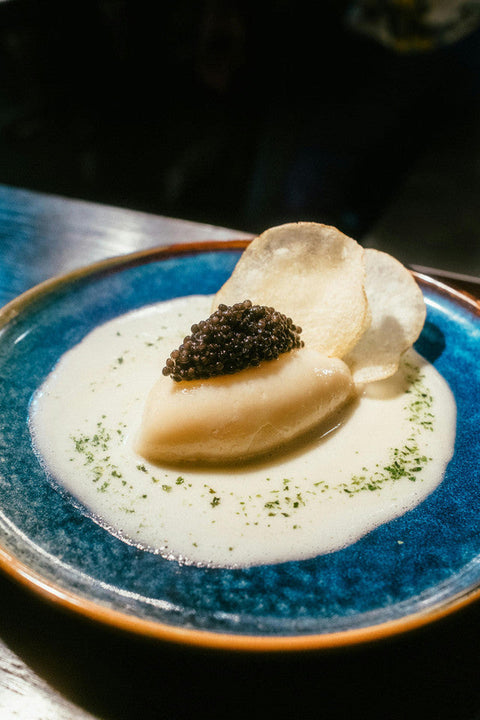In this installment of our Caviar Star Fact Check series, we’re taking a closer look at a widely circulated article titled “Caviar Fun Facts.” While lighthearted in tone, its claims are presented as fact, and when it comes to caviar, accuracy matters. Our goal is to make sure that every consumer is empowered with the truth behind this timeless delicacy.
Why Is It Important to Know the Facts About Caviar?
Caviar is more than just a luxury item—it’s a product rooted in history, ecology, and craftsmanship. Misinformation can lead to poor purchasing decisions, support for unsustainable practices, or missed opportunities to experience caviar at its best. We believe knowledge enhances enjoyment. When you know where your caviar comes from, how it’s produced, and how to serve it, every bite becomes more meaningful—and more delicious.
Let’s take a closer look at some caviar “facts”:
CLAIM: “Caviar is any single salted fish roe or egg. True caviar comes from the icy waters of the Caspian Sea from the finest sturgeon. Ninety-five percent of the caviar produced in the world comes from the Caspian Sea. Only three sturgeon species produce this caviar: Beluga, Osetra, and Sevruga.”
FACT CHECK: Partly true, mostly outdated.
True caviar refers exclusively to roe from sturgeon, members of the Acipenseridae family. While the Caspian Sea was once the primary source, decades of overfishing, pollution, and poaching devastated wild populations. Global protections followed, including a U.S. ban on pure Beluga imports in 2005 and tighter CITES regulations in 2006. Today, much of the world’s high-quality caviar is produced through sustainable aquaculture across Europe, Asia, and the U.S. And yes, the Caspian is home to Beluga, Osetra, and Sevruga sturgeon, but it no longer accounts for 95% of global production. A large majority of the caviar in the world today is actually farmed in China.
CLAIM: “Caviar shouldn’t touch metal like silver or it’ll taste metallic. Use crystal bowls and gold, glass, or wood spoons.”
FACT CHECK: True.
Serving caviar in metal—especially silver—can affect its delicate flavor. According to America's Test Kitchen science research editor, Paul Adams, "when silver touches the tongue, it can create a mild electrical current, which we perceive as a coppery, metallic taste. In the presence of salt, the current flows much more readily—hence the overwhelming unpleasantness of the caviar we tasted off the silver spoon."
Glass, bone, mother-of-pearl, or gold utensils preserve taste integrity, but we wouldn't reccomend a wooden spoon as it could impart undesired flavor. Crystal or shell serving dishes, chilled before use, are ideal for maintaining freshness and enhancing the experience. Keep in mind that caviar is typically stored in metal tins right after harvesting, which can impart metallic flavors if stored too long and if there's no protective lining on the metal.
CLAIM: “To serve caviar properly, it should be kept on ice.”
FACT CHECK: True.
Temperature matters. Caviar should always be served well-chilled—ideally on a bed of crushed ice. Never freeze it, and avoid serving at room temperature, as both can compromise texture and flavor.
CLAIM: “Sturgeon have survived since the age of dinosaurs. Commercial fishing dates back to 1100 BC, and Ancient cultures enjoyed caviar.”
FACT CHECK: Partly true.
Sturgeon are indeed prehistoric fish, with origins dating back over 200 million years. As for historical consumption, caviar was famously mentioned during the Mongol Empire in the 13th century, not necessarily as far back as 1100 BC. Ancient Persians, Greeks, Romans, and Chinese did consume sturgeon roe, but references are limited and more accurately placed in the medieval era.
CLAIM: “A single sturgeon can produce hundreds of pounds of roe.”
FACT CHECK: Possible but exaggerated.
Beluga sturgeon—the largest species—can produce up to 45 pounds of roe around maturity. Smaller farmed varieties like Osetra typically yield 3 to 5 pounds. The idea of “hundreds of pounds” from a single fish is inaccurate, unless referencing cumulative yield over a lifetime—and even then, it's a stretch. The highest yeild of cleaned roe we've seen for farmed sturgeon is close to 13-15% of its body weight. The largest Beluga Sturgeon ever recorded in the wild was over 3,000 lbs, back in 1827, so if she was still producing eggs and stocked full it could've potentially been close to 400 lbs...
CLAIM: “July 18th is National Caviar Day.”
FACT CHECK: True.
Mark your calendars—July 18th is officially National Caviar Day in the United States. The holiday has quickly started making a wave with foodies across the country the past few years. We’ll toast to that.
CLAIM: “Beluga populations have declined by over 90% and may no longer be reproducing in the wild.”
FACT CHECK: True and deeply concerning.
Beluga sturgeon are critically endangered. Due to illegal fishing, habitat loss, and overconsumption, natural reproduction is nearly nonexistent. Recovery now depends on strict regulations, stocking programs, and habitat protection. This is why we only offer farmed Beluga Hybrid caviars that don't naturally occur in the wild, ensuring they are truly sustainable.
CLAIM: “The EU, Switzerland, the U.S., and Japan account for 95% of global caviar imports.”
FACT CHECK: False.
While these countries are significant importers, they don’t account for 95% of global demand. The U.S. alone imports roughly 15% of the world’s caviar, a large majority of it being Chinese (Kaluga Hybrid & Osetra). Nations like the UAE, Malaysia, and Australia also represent key markets.
CLAIM: “The U.S. is the largest market for Beluga caviar, importing 60% of world supplies.”
FACT CHECK: Outdated.
In 2005, the U.S. did import about 60% of Beluga exports. But following the 2006 ban on Beluga caviar, that is no longer true. Today, the U.S. continues to be a major player in the global caviar market, importing 14.7% of total caviar in 2016 (worth approximately $13.6 million)—but Beluga is no longer part of that mix. With the growing number of farms around the world combined with the growth of caviar's popularity in the US the past decade, that number is thought to be even higher now. However, the US does have more caviar farms that ever before but they only make up for a small percentage of the US consumption.
CLAIM: “Caviar is expensive because it’s rare.”
FACT CHECK: True… with nuance.
High-quality sturgeon caviar is indeed rare. Sturgeon are slow-growing fish, and it can take 7–20 years for a female to reach maturity and begin producing roe. Combined with limited harvesting seasons, careful processing, farm operating costs, and conservation efforts, this slow reproductive cycle limits supply and drives up price, especially for prized varieties like Beluga, Osetra, White Sturgeon, and Kaluga.
CLAIM: “The harvesting process is difficult and costly.”
FACT CHECK: True.
Harvesting sturgeon roe is a highly delicate, labor-intensive process that must be done at just the right moment. After many years of raising the sturgeon with close monitoring and care, the roe is harvested, carefully cleaned, sorted by quality, salted ~3% (in the malossol method, typically), and packed—all by hand. This artisanal approach adds significantly to the final price.
CLAIM: “Caviar prices are just inflated because it's trendy.”
FACT CHECK: False.
While caviar is undeniably a luxury product, the price is tied to legitimate factors: endangered species protections, long production timelines, intensive labor, and strict quality standards. You're not just paying for prestige—you're paying for rarity, craftsmanship, and care.
CLAIM: “The type of sturgeon matters in the price.”
FACT CHECK: True.
Yes—different sturgeon yield different types of roe, each with its own flavor, size, texture, and rarity. Beluga, for instance, produces the largest, most delicate eggs and commands the highest price (though it's banned in many countries). Osetra, White Sturgeon, and now Kaluga follow close behind in terms of both prestige and cost. Species like Siberian and Hackleback sturgeon are more affordable due to faster maturation ages but still offer excellent quality.
Know What You’re Tasting, Trust What You’re Buying
We believe that great food starts with great information. Whether you’re indulging in a spoonful of Osetra or exploring our specialty goods, we’re here to keep the facts fresh, just like our caviar.


